Wondering how to get paid partnerships on Pinterest? You’re in the right place!
Note from Jana O.: There’s something important that no one is telling creators about Pinterest brand partnerships… And I’m so EXCITED to be breaking the story…
Brand partnerships are already happening on Pinterest. Many Creators are making money with them, and Pinterest continues to provide us with new tools and features to do so!
But here’s the part that many people don’t really understand about Pinterest brand partnerships… because no one is really talking about it…
For the most part, it’s still up to the individual Creators to pitch and secure the actual brand deals. I’ve noticed that there’s a LOT of desire out there among Creators to learn how to pitch, so I invited my friend Austen to swing by the blog and give us her best tips.
Excited? Meeee toooo!
So over to you, Austen, for this juicy guest post all about how to get paid partnerships on Pinterest…
Hi! Austen here. … And I’m thrilled to be guest posting for Jana’s blog. In this post, I’m reviewing Pinterest’s latest features for paid content. I’ll also be sharing my five best tips for pitching brands as a Pinterest content creator – no matter your follower count!
To give you some quick background on me, I have been a Pinterest user since 2009 and a content creator since 2012.
Even as a micro-influencer, I’ve been able to partner with brands like Amazon, Kohl’s, Walmart, L’Oreal, and more on paid collaborations across my social media platforms by being persistent, showing my value, and most importantly, creating great content.
Ready to learn about Pinterest brand partnerships?
Let’s start with some background: a bit about how Pinterest is changing. Then we’ll dive into its newest feature, the paid partnership label. And then we’ll be ready to fill you in on how to get paid partnerships on Pinterest.
How has Pinterest changed – and where do brand partnerships fit in?
When I first joined Pinterest I was curating boards of other people’s content, just for fun. It was a place to go for inspiration, but it wasn’t yet a “social” platform.
Between 2010 and 2019 Pinterest became the largest visual search platform in the world and by doing so became a huge traffic-driving source for bloggers and creators.
At the time, Pinterest was a platform where bloggers would come and share teaser content to direct people back to their blog, website, YouTube channel, or other platforms.
Back then, it was less about creating content for Pinterest and more about creating content that would get outbound clicks to achieve a desired goal—whether that be website traffic to generate ad revenue, leading someone to a shop to make a purchase and earn an affiliate commission, or to sell a product or service.
In a nutshell, Pinterest wasn’t initially a place where creators cultivated community or made money—it was a means to a different end.
But then in 2020, Pinterest introduced Idea Pins (formerly known as Story Pins). They were designed to keep users on the platform more – because while Idea Pins had many of the same elements as regular pins (titles, descriptions, and tags) they were missing a crucial component—external links.
Many traditional bloggers moved away from Pinterest as a result of this decision, but many creators joined the platform because of it as well.
Today there are many ways that creators can monetize directly with Pinterest – thanks to Idea Pins:
- The Creator Fund (an accelerator program that opens seasonally to different categories of creators)
- Affiliate link stickers in idea pins
- Brand partnerships (aka sponsored content)
What is the paid partnership tool on Pinterest?
Pinterest recently rolled out their branded partnership tool on the platform that allows creators to clearly disclose and identify branded content to their followers.
Here’s what it looks like at the time we’re publishing this post. (You’ll find it in the “Advanced settings” area of the Pinterest Idea pin builder on mobile.)
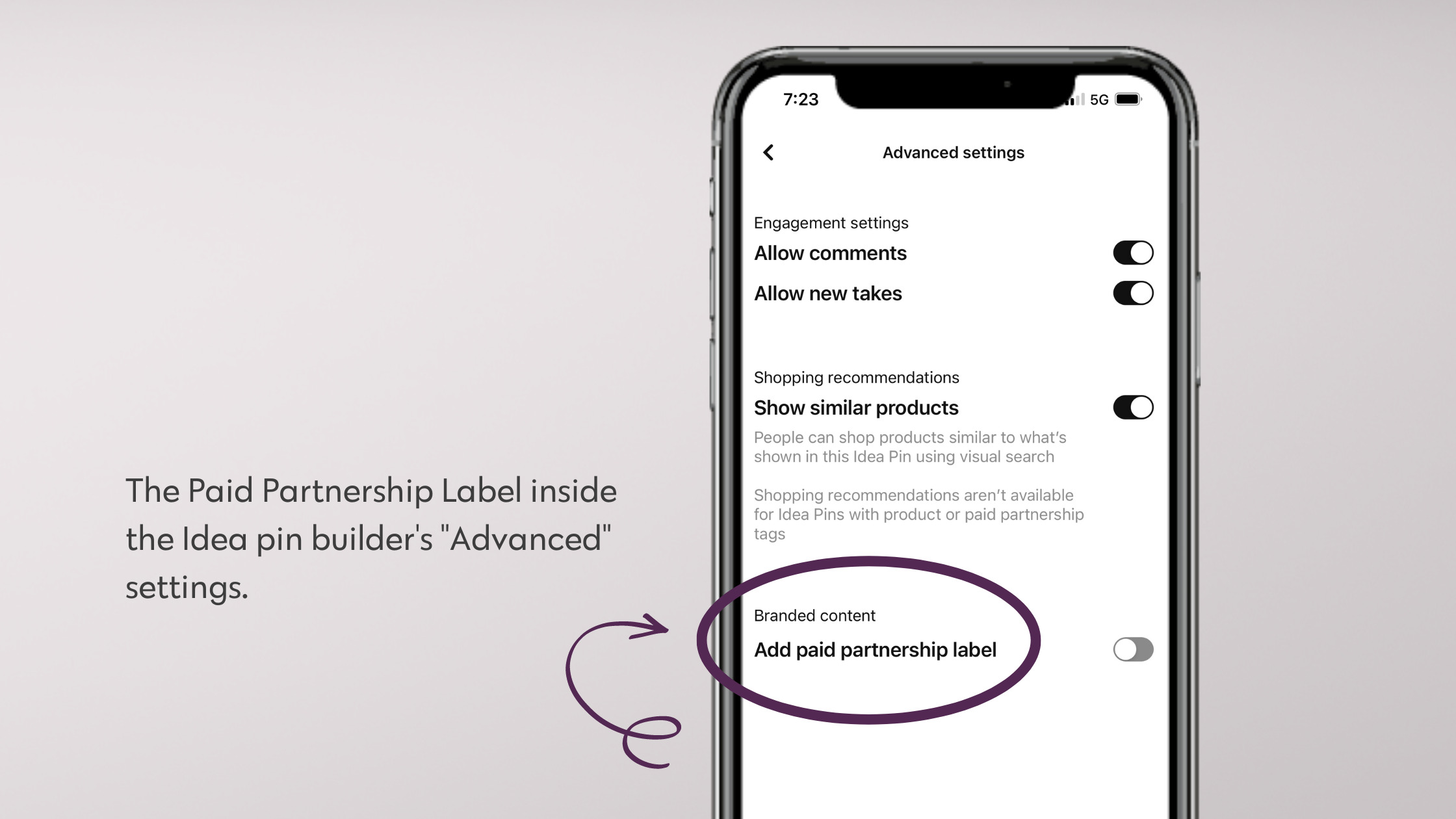
What is paid partnership on Pinterest?
Branded content (also called sponsored content or paid partnership content) is any content that has been created as a result of an agreement between a brand and a content creator.
Branded content implies an exchange of money, meaning a creator was paid by the brand to create that certain piece of content.
How do you become eligible for branded content on Pinterest?
Here’s the great thing about Pinterest’s branded content program: If you have a Pinterest business account, and the desire and know-how to pitch brands – you can participate.
And you don’t have to have a huge follower count on Pinterest to make money through brand collaborations. (More on that below.)
Most Creators who have the “Creator Hub” button on Pinterest will see a tab called, “Branded Content.” Technically, if you have that tab, you are “eligible.” But essentially, that just means Pinterest encourages you to pitch brands for paid / user-generated content (UGC) deals – and deliver on them with Pinterest content!
(For the moment, it’s up to you as the Creator to obtain these brand partnerships. Pinterest seems to be working on some programs to match Creators with brands. But for now, I suggest you sharpen your pitching skills – and shoot your shot with brands! … More on how to get paid partnerships on Pinterest below.)
When should I use the Pinterest brand partnerships tool on my pins?
You should only use this tool to identify branded content that you were paid to create by a brand that has hired you to create content for them.
Here is an example of a paid partnership I did with Kohl’s over the holidays where they hired me to create two Idea Pins for them showcasing holiday gift sets available at their Sephora section. (I had early access to this feature in 2021.)
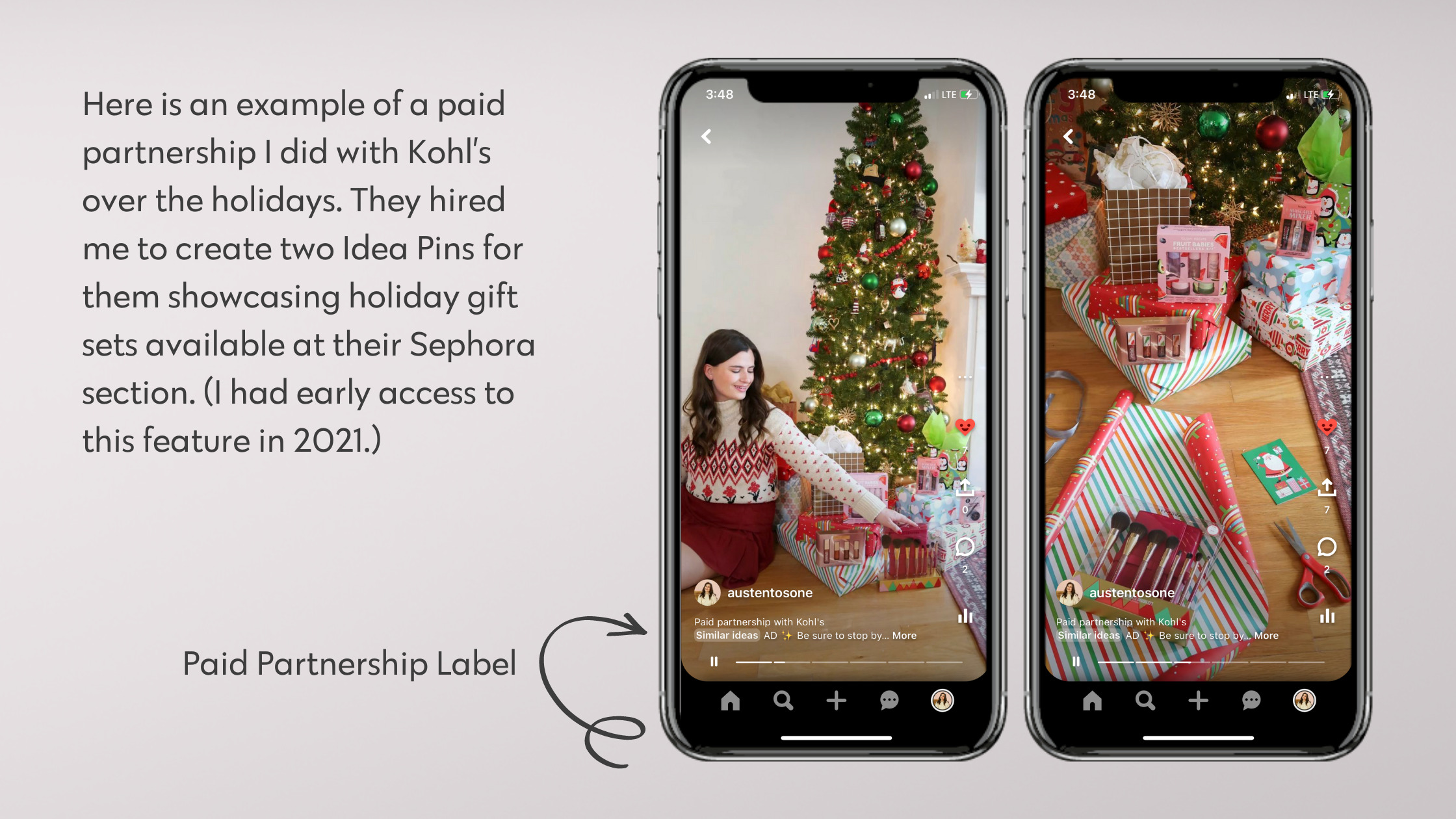
Depending on your agreement with the brand, using the paid partnership label will also allow the brand to boost (or white label) your content by putting ad spend behind a pin to get it in front of more people.
Pinterest introduced this tool because creators must properly disclose branded content per the FTC guidelines.
Be sure to only use the paid partnership tool when you were paid by a brand to create content. If you were to use it without an agreement with that brand, you’d be misrepresenting your relationship with the brand.
If you’re interested in trying to get a brand’s attention with an amazing piece of content, don’t worry! There are better ways to do it!
In fact… let’s get into the details about pitching brands as a Pinterest creator – and how to actually get paid partnerships on Pinterest.
First, why pitch brands?
As Jana mentioned in her intro above, for the most part, it’s up to you as the Pinterest Creator to pitch and win the brand partnerships. So how does one actually do this?
Typically, there are three ways for content creators to secure a partnership with a brand:
- You reach out to them
- They reach out to you
- You can apply to campaigns on influencer platforms like Aspire, Collectively, Fohr, Obviously, or the InfluenceHer Collective
If you’re a smaller creator, you’re more likely to land collaborations by pitching or applying to campaigns through influencer platforms – because brands may not be reaching out to you directly (yet!).
Out of those two options, I’d strongly recommend pitching because you can build a direct relationship with a brand with no middleman. You can create agreements on your own terms – unlike on influencer platforms which often have set deliverables and rates that are hard to negotiate.
Plus, pitching isn’t just helpful for making money from brands—it truly is a life skill and no matter what you do professionally, being able to communicate your value to others is key to being successful.
Ready for my top 5 tips for pitching brand collaborations as a Pinterest creator? Let’s dive in!
Tip 1: To attract Pinterest brand partnerships, prep your Pinterest profile!
Before you pitch a brand, you want to make sure that your Pinterest profile is in tip-top shape.
Think of a brand you want to pitch and then put yourself in that brand’s shoes. If they were to stumble across your Pinterest profile today, are there elements of your profile that would stand out to them and help them envision what a partnership together could look like?
For example, if you’re pitching a beauty brand but you haven’t posted any beauty content recently, they may look at your profile and think that you’re not the right match to share their products.
Make sure that…
✔️ your name is clearly listed
✔️ you have a profile photo that is consistent with your profile photo on other social media channels
✔️ you list a website and claim that website
✔️ you have a profile description – so the brand representative can see what your Pinterest account is all about at a glance.
To help you get your profile optimized to win Pinterest brand partnerships, I recorded a short video to share about some of the choices I’ve made with my profile. Press play below to watch it!
Tip 2: Think “Quality > quantity” when pitching brand partnerships.
A few years ago, creators could get away with writing a generic pitch email. They could just send it out to hundreds of brands and just swap in a different name.
Today, brands get so many pitches from influencers and creators that it’s better to focus on trying to build genuine connections with a few brands you really love.
So brainstorm a list of 10-15 brands you think you may want to work with. Not sure where to start? Walk through your daily routine in your head.
What are you using to wash your face? Make your coffee? Walk your dog? Organize your tasks?
Start to jot down brands that you use on a day-to-day basis and that you’re super familiar with – so you can make a stronger case when you reach out.
A good pitch email will answer three questions:
- Why you? Why are you the right person for them to hire?
- Why them? Why would they be a good fit for your audience and content?
- Why now? Is there a timely reason that this collaboration should happen?
Spending the time writing personalized emails increases the odds that you’ll get a response and is well worth it!
Okay, on to tip #3 (It’s a critical one!)
Pssst… pin this pin to reference again later! 📌
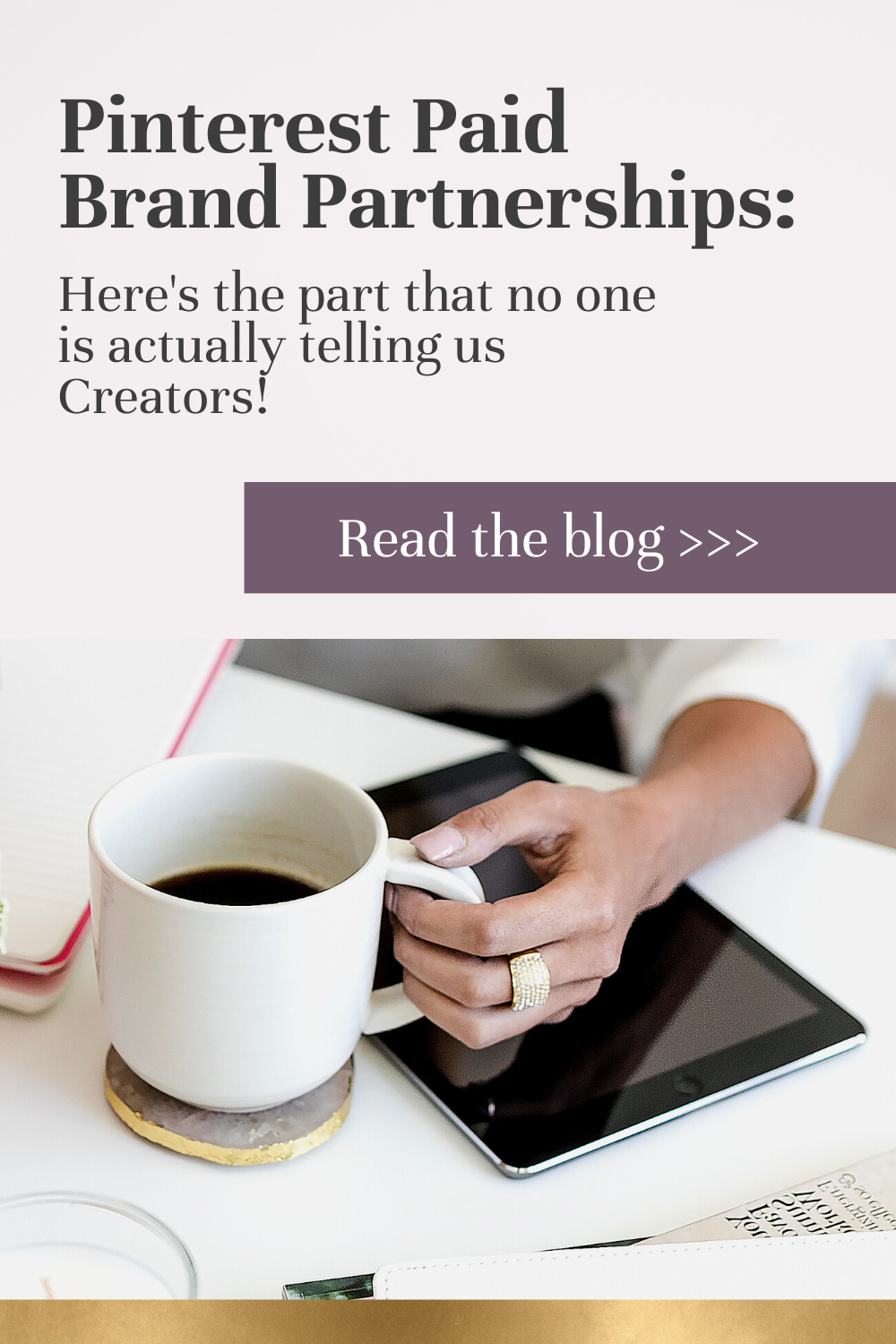
Tip 3: When pitching brand partnerships, pitch the right person!
When it comes to pitching, half of the battle is getting your pitch in the hands of the right person. This applies for Pinterest brand partnerships – and deals for any platform, of course!
The person you’ll ideally want to reach out to at the brand you’re planning to pitch is someone in a marketing role.
Sometimes this person might have a broad job title like “marketing manager” and other times their title will be more clear like “influencer relations coordinator.”
There are a few different ways to find brand contacts, so let’s review all of the places you can look for them:
- Google: sometimes finding an email can be as easy as a simple Google search, and you can even look up if a brand has a particular email format. If a brand uses the format firstinitiallastname@companyname.com then if you find a name later, you can guess their email.
- The brand’s website: try heading to the brand’s website and see if they have a contact page where they may list an email for press inquiries or creator inquiries.
- LinkedIn: do a few searches with the brand name and titles like “influencer relations” “influencer coordinator” “community manager” “marketing manager” “public relations representative” and so on.
- Facebook groups: sometimes creators will be willing to trade contacts or share a contact that they’ve worked with in the past so feel free to ask away in groups and be prepared to swap contacts via Facebook Messenger.
One thing I generally advise creators to avoid is pitching brands directly via Instagram DM.
Instagram can be a great platform to build a relationship with a brand by tagging them in stories to get their attention and hopefully have them respond to you.
However, oftentimes the person who answers a brand’s Instagram DM’s isn’t the person who casts for influencer collaborations. So your effort there could be wasted.
Email is the most common way to pitch brands and in my opinion, the more professional option too.
Tip 4: Get specific about what it is you’re pitching!
Your pitch email is your chance to really wow a brand. I recommend keeping it short and sweet since the person on the receiving end of your note likely has a busy inbox.
So with that, your pitch email should contain a clear ask and get the person on the other end of it excited about your idea.
Sending a note that simply says, “I’d love to collab!” doesn’t cut it in 2022.
Do you create really fun Pinterest Idea Pins doing makeup challenges that always go viral? Ask a makeup brand if they’d like their newest product to be featured in the next one.
Do your smoothie-making Idea pins always garner tons of engagement? Ask your chosen kitchen appliance brand if they’d like to be spotlighted.
Does your favorite home decor brand always do a big holiday sale? Reach out a few months ahead of time and share an idea to promote the sale to your Pinterest audience.
Get creative and communicate your unique value to the brand.
Tip 5: Numbers and examples can help make your Pinterest brand partnership pitch an easy “YES!”
My final tip is all about giving the brand representative exactly what they need to say “heck yes!” to your idea.
That’s right—I’m talking about analytics.
You may look at your analytics as a content creator to figure out what content of yours performs best or what to create more of.
But analytics can also be a powerful tool to help convince brands that they should hire you to create content for them.
For example, brands are more likely to partner with creators who create for a similar demographic as the people they are trying to sell their products or services to.
To find out who your audience is in your Pinterest business profile, go into the analytics tab and select “audience insights.” There you’ll be able to see the age, gender and location of your audience.
I know my audience is mainly millennial women who live in major US cities, so that puts me in a good position to pitch fashion and beauty brands that may have millennial customers.
And, if you’ve created content featuring their brand or similar brands before, definitely send them an example or two along with your pitch.
You can simply add a link to an example directly within your email to make it easy for them to find. This will also allow them to see your content style, which will help them envision what your partnership might look like.
Closing Thoughts: Can you get brand deals on Pinterest?
Wondering if YOU could get brand partnerships? (Even if you don’t have thousands upon thousands of followers?) Well, here’s the deal…
Pinterest has evolved a lot as a platform, especially in the last two years, and it’s clear that they are working on prioritizing the on-platform experience, including introducing new ways for creators to monetize. And…
Anyone can make money through brand collaborations on Pinterest, no matter the size of your following! (You just need to know how to pitch!)
When you reach out to brands about Pinterest brand partnerships, be clear about who you are, who your audience is, and what value you can provide them through your content.
And if you want more tips on how to turn your social media platforms into a thriving creator business, you can download my free guide The Influencer Launchpad here to get started.

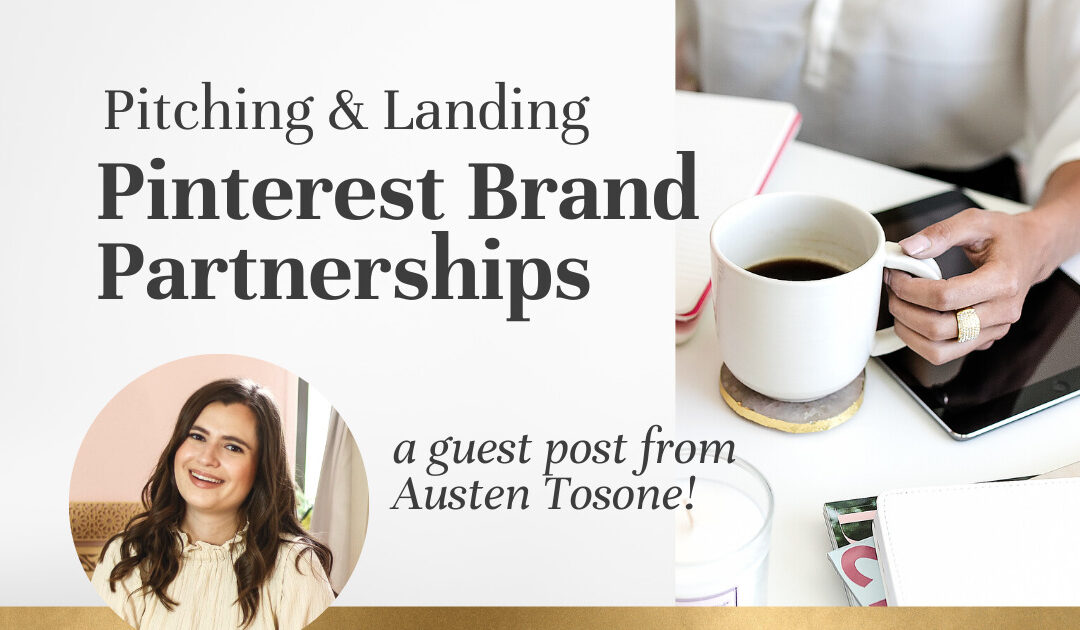
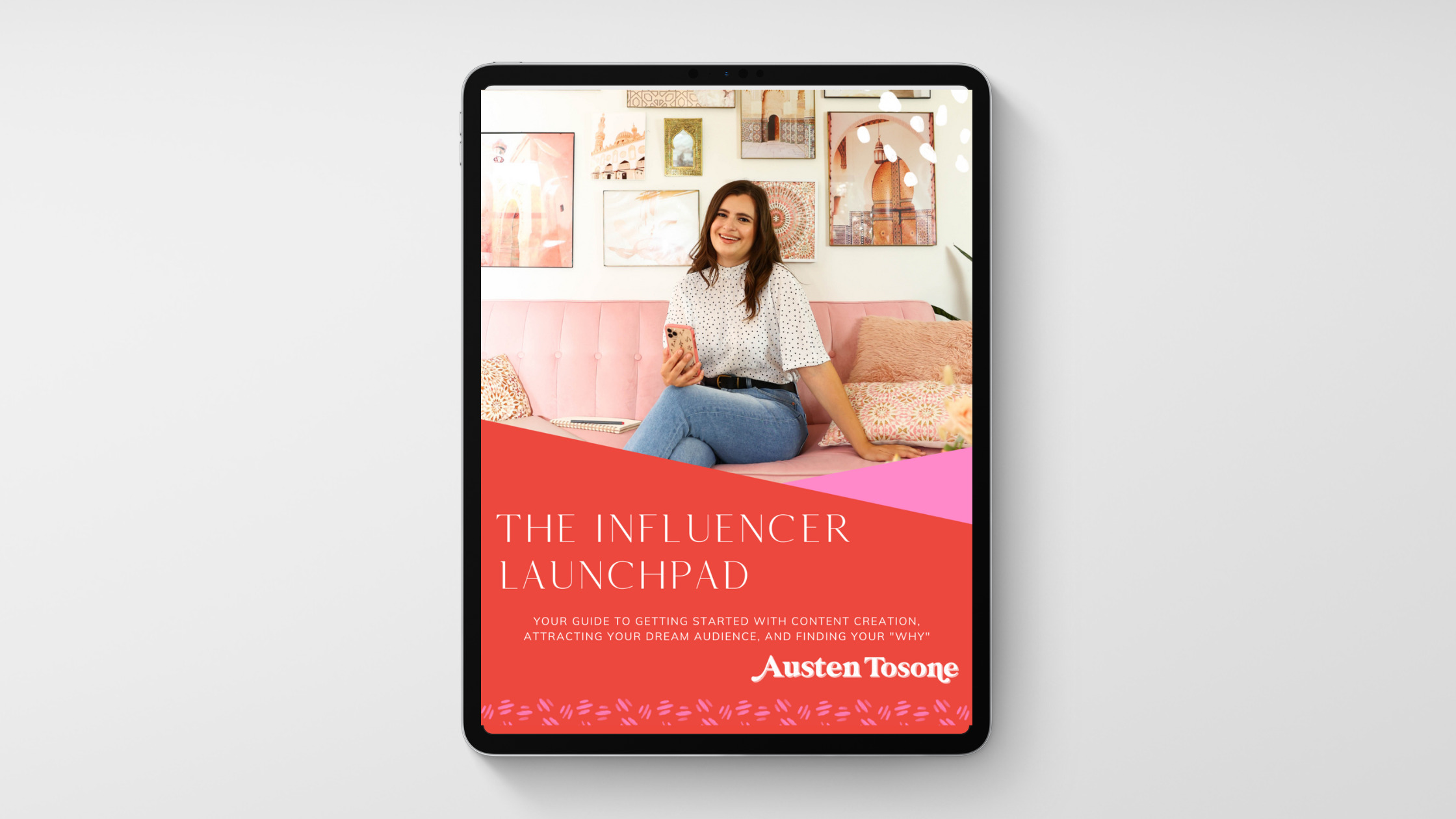
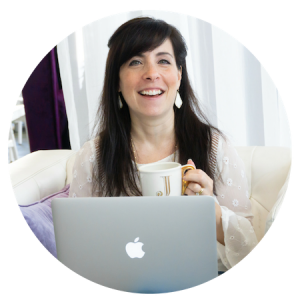
I am so confused and frustrated because no one is talking about this . How can Pinterest say am eligible for branded content but the Partnership label does not exist in my advanced > , please reply if you can . I have deleted my Pinterest because of this